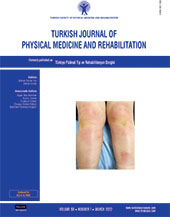Evaluation of clinical relationship of serum niacin and dopamine levels in patients with fibromyalgia syndrome
2 Department of Physical Medicine and Rehabilitation, Tokat Gaziosmanpaşa University Faculty of Medicine, Tokat, Turkey DOI : 10.5606/tftrd.2022.8529 Objectives: The aim of this study was to investigate the role of serum niacin and dopamine (DA) levels and their clinical importance in fibromyalgia syndrome (FMS) patients.
Patients and methods: Between April 2018 and October 2018, a total of 53 female patients (mean age: 38.3±5.5 years; range, 21 to 45 years) with a clinical diagnosis of FMS and 35 healthy female controls (mean age: 36.7±5.2 years; range, 25 to 44 years) were included in this cross-sectional study. The Visual Analog Scale (VAS), Beck Depression Inventory (BDI), and Fibromyalgia Impact Questionnaire (FIQ) were applied to the patients. Serum levels of niacin and DA were measured by high-performance liquid chromatography (HPLC) and enzyme-linked immunosorbent assay (ELISA) methods, respectively.
Results: Niacin and DA levels of the patient group were significantly lower than those of control group (p=0.003 and p=0.02, respectively). A very strong positive correlation was found between niacin and DA levels (r=0.96 p<0.001). Evaluation of the diagnostic performance of niacin and DA by the receiver operating characteristic analysis yielded an area under the curve (AUC) of 0.73 (p<0.001, 95% confidence interval [CI]: 0.62-0.85) and an AUC of 0.68 (p=0.004, 95% CI: 0.56-0.80), respectively.
Conclusion: Serum niacin and DA levels decrease in FMS patients in relation to the tender point numbers. It can be suggested that the levels of these two markers can be considered additional tools in the diagnosis of FMS.
Keywords : Dopamine, fibromyalgia syndrome, niacin, pain, point number, tender

















